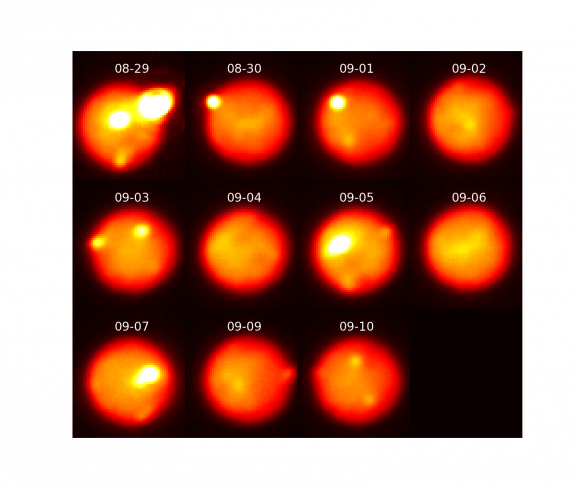Jupiter’s innermost moon, Io — with over 400 active volcanoes, extensive lava flows and floodplains of liquid rock — is by far the most geologically active body in the Solar System. But last August, Io truly came alive with volcanism.
Three massive volcanic eruptions led astronomers to speculate that these presumed rare outbursts were much more common than previously thought. Now, an image from the Gemini Observatory captures what is one of the brightest volcanoes ever seen in our Solar System.
“We typically expect one huge outburst every one or two years, and they’re usually not this bright,” said lead author Imke de Pater from the University of California, Berkeley, in a press release. In fact, only 13 large eruptions were observed between 1978 and 2006. “Here we had three extremely bright outbursts, which suggest that if we looked more frequently we might see many more of them on Io.”
De Pater discovered the first two eruptions on August 15, 2013, from the W. M. Keck Observatory in Hawaii. The brightest was calculated to have produced a 50 square-mile, 30-feet thick lava flow, while the other produced flows covering 120 square miles. Both were nearly gone when imaged days later.
The third and even brighter eruption was discovered on August 29, 2013, at the Gemini observatory by UC Berkeley graduate student Katherine de Kleer. It was the first of a series of observations monitoring Io.

De Kleer and colleagues were able to track the heat of the third outburst for almost two weeks after its discovery. The team timed observations from Gemini and NASA’s nearby Infrared Telescope Facility to coincide with observations by the Japanese HISAKI spacecraft.
This allowed the observations to “represent the best day-by-day coverage of such an eruption,” said de Kleer. The team was able to conclude that the energy emitted from the late-August eruption was about 20 Terawatts, and expelled many cubic kilometers of lava.
“At the time we observed the event, an area of newly-exposed lava on the order of tens of square kilometers was visible,” said de Kleer. “We believe that it erupted in fountains from long fissures on Io’s surface, which were over ten-thousand-times more powerful than the lava fountains during the 2010 eruption of Eyjafjallajokull, Iceland, for example.”
The team hopes that monitoring Io’s surface annually will reveal the style of volcanic eruptions on the moon, the composition of the magma, and the spatial distribution of the heat flows. The eruptions may also shed light on an early Earth, when heat from the decay of radioactive elements — as opposed to the tidal forces influencing Io — created exotic, high-temperature lavas.
“We are using Io as a volcanic laboratory, where we can look back into the past of the terrestrial planets to get a better understanding of how these large eruptions took place, and how fast and how long they lasted,” said coauthor Ashley Davies.
The latest results have been published in the journal Icarus.


Io is well up there in my ‘Favorite Solar System Objects’ list.
Such a dynamic and crazy place.
If it werent for the mysteries beneath the surface of places like Europa, Enceladus and Ganymede, Io would be my favorite Moon in general, because Im just a sucker for (real) colour in Astronomy.
Not to mention it just looks so cute casting its shadow on Jupiters cloud tops.
Yes, such a violent and savage place….a boiling world of sulphur and molten metal (arguably more fascinating than a sub surface water ocean, IS Io and its sub surface boiling ocean of….well I dont think anyone quite knows yet do they?), that despite being so tiny, heavily influences the music of Jupiter, in the form of powerful radio bursts that coincide with Io’s passing.
Lovely little boiling Io and its eruptions, a great story to get me up and moving this morning, thanks Shannon!
For anyone interested, the link to the actual paper: http://www.sciencedirect.com/science/article/pii/S0019103514003303 (to the paywall, actually).
“New images…”
You meant: “one-year old images”…don’t you ?
Why are they kept hidden for (almost) one year ?
“Why are they kept hidden for (almost) one year?”
To do science with it, of course. It involves procuring data, validating it, and probably the longest phases of such an endeavour, analysing it, interpreting the results — the last two may involve going back and forth — and writing the paper. Since the observation team (the selected group of astronomers who had requested observing time on the telescope with a clearly stated objective) usually gets the first shot at figuring out what’s happening, the data and results may not be released until the team are ready. At least, that’s my general understanding.
By the way, the paper was first published around late June.